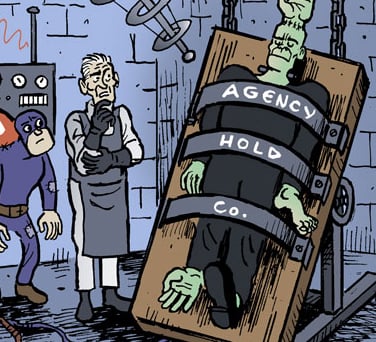What are the first items to get cut from corporate budgets during an economic downturn?
Let’s ask one of the nation’s top business schools for the answer: According to Northwestern University’s Kellogg School of Management, most firms cut things like travel and education. At least that was Kellogg’s experience when enrollments in its executive education program plummeted a few years ago.
Participant days, the metric by which Kellogg measures success, fell in 2003 to 50% of what they had been during 1999, the peak year, largely because executive ed is “hypersensitive” to economic conditions, said Meghan Tracy, marketing manager for executive education at the Evanston, IL-based school.
And that wasn’t the only problem. “At the same time, the marketing department had a huge turnover and a change in leadership,” Tracy added, speaking at the Chicago DM Days & Expo last month.
The first challenge faced by the new management team was to rebuild the department. Tracy was brought in along with a database manager and an electronic media manager.
That done, the unit started revamping its direct mail program. “We traditionally mailed brochures in No.10 envelopes without a cover letter, and blanketed executives everywhere without a lot of insight into [who to] target,” Tracy said.
The school redesigned all of its print collateral materials so they had a fresher look, with less copy. That entailed reducing the faculty bios — “a huge deal for anyone who works with professors,” Tracy laughed.
In addition, the school wrote personalized letters customized by program and target market segment. It included a call to action backed up with customized applications and business reply envelopes. And it tightened up its targeting to make use of variables like SIC, size of company, revenue, geography and title.
Kellogg studied “who the participants were, and which companies they were coming from,” Tracy said. The school also wanted to know if people had attended more than one program, and [asked former students] to identify additional contacts within its top companies so it could “market deep.”
These changes worked wonders with a 50,000-piece mailing during the fall of 2003. The overall response rate to the house file was 2.88%, compared with an industry benchmark of 2.58%. The direct sales rate, or conversion, was .43%, compared with a historical rate of .10%. The return on investment was 34:1. However, the latter might have been a bit inflated because “we focused on house file names for that campaign,” Tracy said.
But the changes didn’t stop with direct mail. Kellogg signed on a new ad agency — Leo Burnett — and tried to get away from traditional school advertising that showed “smiling faces and ivy-covered buildings,” Tracy continued. “Kellogg’s also known as a good marketing school, one of the best, and we felt that our advertising needed to stand up to that.”
One ad showed empty office cubicles with a clutter of phones on one shelf. It was headlined “The Before or the After?” The copy in the purple box at the bottom explained, “Merger Week: Creative value through strategic acquisitions and alliances.”
“The payoff is in the purple box,” Tracy said. “It’s the name of one of our programs that addresses the issues raised in the headline.”
Another headline asked: “Motive or Mandate?” The payoff: “Energizing people for performance.”
Yet another asked: “Gold Mine? Or Land Mine?” It showed a picture of an annual report. The offering in the purple box: “Forensic accounting for credit and equity analysts.”
The tag line said it all: “A program where the business world’s most courageous minds tackle its most challenging issues.”
The campaign was launched last May with half-page ads in The Wall Street Journal, Financial Times, BusinessWeek and Harvard Business Review. Each ad included a URL and a telephone number. Kellogg also changed its Web site to accommodate multiple brochure requests.
“On a tactical level, we hadn’t allowed people to request more than one brochure when they came to our Web site,” Tracy said.
The results? The effort generated a 52% increase in number of unique brochure requesters. In May, the campaign drew 2,844 hits to the Web site, 5,605 in June, 1,230 in July and 5,376 in August. In addition, it increased overall traffic to the site by about 16%.
The campaign also boosted the number of both participants and program days by 2% and 3%, respectively. The only metric that fell off was the number of participant days, but that reflected a turn away from three- and four-week programs.
Since then, Kellogg has completed a “significant database cleanup project” and tested numerous rental files. It also tweaked its creative and added online sites to the BusinessWeek.com domain it had tried in 2003. And it sent out 120,000 direct mail pieces, largely to rental lists, in the fall of 2004.
That mailing drew a response rate of 12.83% (to the house file) and a conversion of .41%. The return on investment for the whole effort clocked in at 12:1. Tracy attributed the dip in ROI from the prior mailing to the cost of additional list rentals.
And the campaign’s overall results? The number of participants increased by 16%, program days by 2% and participant days by 20%. Moreover, the school has added new subject areas as well as a one-day program.
What’s next? According to Tracy, Kellogg hopes to put the old 80/20 rule to work.
“The top 100 companies supporting Kellogg Executive Education represent 25% of all enrollments and 21% of all brochure requesters,” she said. “We have to nurture relationships with those companies.” Kellogg also wants to examine its offerings and pricing to improve conversion.
Is Tracy pleased? While she acknowledged that “it’s still an uncertain market,” she added: “These are good signs for us.”
 Network
Network

